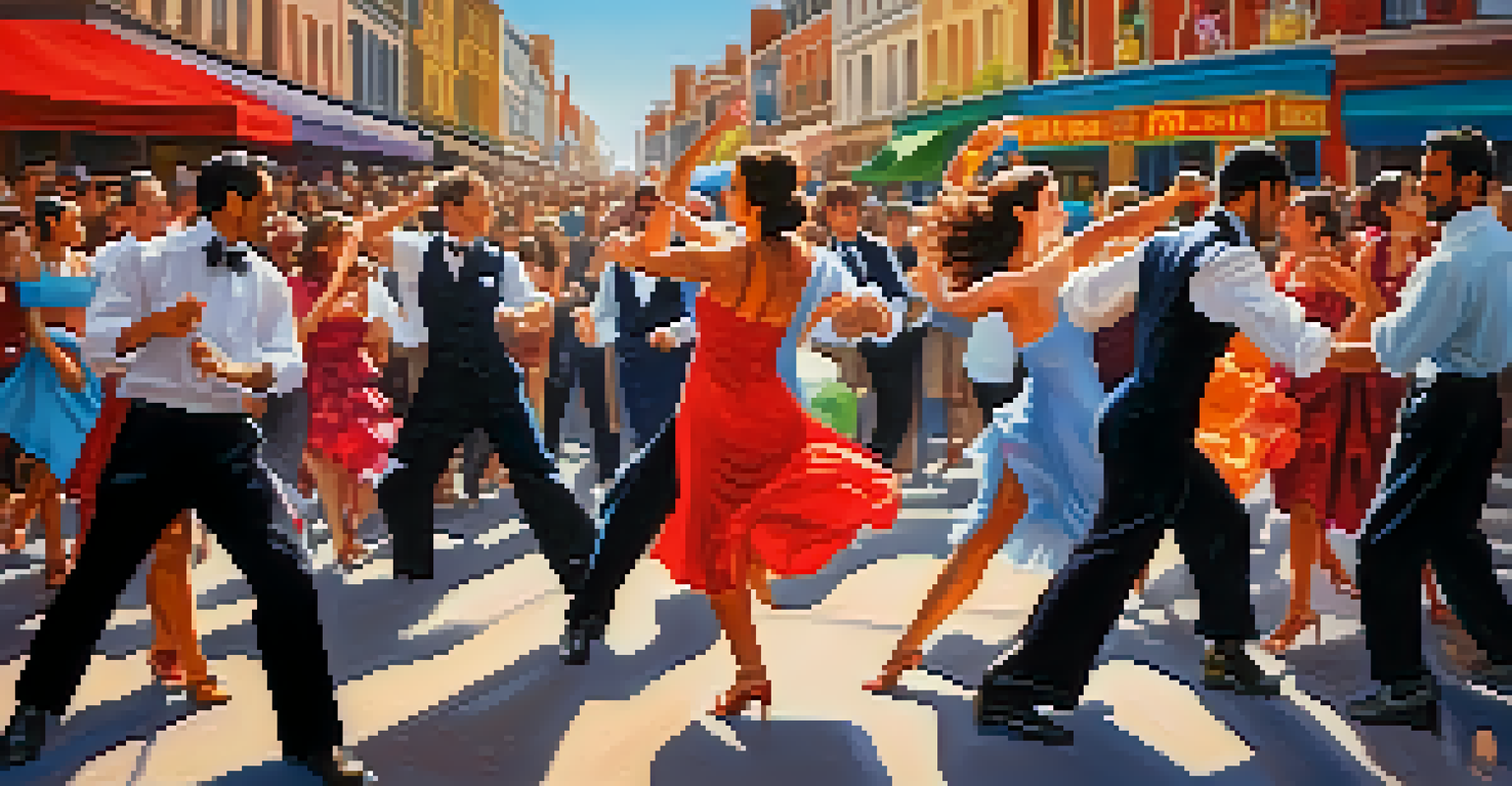The History of Tango: Passion, Culture, and Social Interaction

The Origins of Tango: A Melting Pot of Cultures
Tango's roots can be traced back to the late 19th century in Argentina, where diverse immigrant communities converged. This cultural melting pot included influences from African, European, and indigenous music and dance forms, creating a unique blend. The dance originally emerged in the working-class neighborhoods of Buenos Aires, where social interaction flourished amidst the bustling urban life.
Tango is the only dance that can be danced with your heart, not just your feet.
Initially, tango was a dance of the lower classes, often performed in bars and dance halls. It was a way for people to connect, express their emotions, and escape the hardships of daily life. The raw passion and improvisational style captured the hearts of dancers and spectators alike, laying the groundwork for its evolution.
As tango gained popularity, it transcended social boundaries, inviting people from all walks of life to join in. This blend of cultures and backgrounds paved the way for tango to become a symbol of Argentine identity, reflecting the country’s rich history and social dynamics.
The Evolution of Tango: From Street to Stage
By the early 20th century, tango began to evolve from its humble street origins into a more stylized performance art. As it captured the attention of the upper classes, it moved from the back alleys to grand theaters, gaining international acclaim. This transformation involved the incorporation of new musical elements, such as the bandoneón, which added depth and emotion to the dance.

The rise of tango orchestras and the introduction of formal dance styles contributed to its growing popularity. Iconic figures, like Carlos Gardel, emerged during this time, bringing tango music to the forefront of popular culture. Films and recordings further propelled tango into the global spotlight, leading to a wider audience.
Tango's Cultural Roots and Evolution
Tango originated in Argentina as a blend of diverse immigrant cultures and has evolved from a street dance to a celebrated performance art.
However, this transition also sparked debates about authenticity versus commercialization. While some embraced the refined style of stage tango, others held onto the raw, improvisational spirit of its origins. This ongoing dialogue continues to shape the identity of tango today.
Tango as a Social Interaction: Connection Through Dance
At its core, tango is not just a dance; it's a form of social interaction that fosters connection between people. The embrace shared by partners creates an intimate space where emotions flow freely, allowing for a unique exchange. This emphasis on connection is what makes tango so appealing, drawing individuals from diverse backgrounds together on the dance floor.
Tango is a conversation between souls, a connection that transcends language.
Tango events, known as milongas, serve as community gatherings where dancers come to share their passion. These social dances encourage a sense of belonging and camaraderie, often leading to lasting friendships and even romantic relationships. The atmosphere is infused with warmth and acceptance, making it a welcoming environment for newcomers and seasoned dancers alike.
Moreover, tango promotes non-verbal communication, as partners must work together to interpret the music and respond to each other's movements. This dance transcends language barriers, allowing individuals to connect on a deeper level. Through tango, people find a shared experience that resonates beyond the dance floor.
The Globalization of Tango: A Worldwide Phenomenon
In recent decades, tango has seen a remarkable globalization, captivating audiences far beyond its Argentine roots. Dance schools and festivals promoting tango have sprung up across the globe, from Europe to Asia, each adding their own flair to the dance. This international interest has led to the creation of diverse styles and interpretations, enriching the tango tradition.
As tango travels, it adapts and evolves, reflecting the unique cultures it encounters. For instance, in countries like Japan and Italy, local influences have introduced new elements while still honoring the dance's original essence. This adaptability has made tango a vibrant and ever-evolving art form, resonating with people of all ages.
Tango as a Global Phenomenon
In recent years, tango has gained worldwide popularity, adapting to various cultures while raising questions about authenticity and preservation.
However, this global popularity also raises questions about authenticity and preservation. As tango becomes more commercialized, some enthusiasts worry about losing the essence of its cultural roots. The challenge lies in balancing innovation with respect for the traditional practices that have shaped tango's identity.
Tango Music: The Heartbeat of the Dance
Tango music plays an integral role in the dance, serving as both the heartbeat and emotional backdrop. Characterized by its rich melodies and complex rhythms, tango music evokes a range of feelings, from passion to nostalgia. The bandoneón, a type of concertina, is particularly iconic in tango orchestras, creating a sound that is instantly recognizable.
The lyrics of tango songs often tell stories of love, loss, and longing, resonating deeply with dancers. This lyrical depth adds another layer to the emotional experience, allowing dancers to express their feelings through movement. The interplay between music and dance is what makes tango so captivating and powerful.
As tango continues to evolve, so does its music, with contemporary artists experimenting with fusion genres and modern interpretations. This evolution keeps the tradition alive while attracting new audiences who appreciate the blend of old and new. Ultimately, tango music remains the soul of the dance, uniting people through its shared emotional experience.
The Role of Tango in Argentine Culture and Identity
In Argentina, tango is more than just a dance; it is a significant cultural symbol that reflects the nation's identity. It embodies the spirit of Argentine creativity, resilience, and passion, often celebrated in festivals and national events. Tango has become a source of pride for Argentines, showcasing their heritage to the world.
The dance also serves as a lens through which to view Argentina's complex social history, including themes of immigration, class struggle, and cultural fusion. Through tango, people gain insights into the country's past, making it a living history that continues to evolve. This connection to history fosters a sense of community and belonging among dancers.
Preserving Tango's Future
The future of tango hinges on balancing its rich traditions with innovative interpretations, ensuring its relevance for new generations.
Moreover, tango has been recognized by UNESCO as an Intangible Cultural Heritage of Humanity, highlighting its global significance. This recognition has helped to elevate tango's status on the world stage, ensuring its preservation for future generations. In this way, tango stands as a testament to the power of cultural expression and the bonds it creates.
The Future of Tango: Preservation and Innovation
As we look to the future, the challenge for tango lies in balancing preservation with innovation. While it is essential to honor the roots and traditions of tango, there is also room for creativity and exploration. Many dancers and musicians are finding new ways to interpret the dance, ensuring it remains relevant in a rapidly changing world.
Workshops, festivals, and online platforms are helping to keep tango alive, providing opportunities for people to learn and connect. The rise of social media has also played a significant role in promoting tango, allowing enthusiasts to share their passion and experiences globally. This connectivity fosters a sense of community, even among those miles apart.

Ultimately, the future of tango will depend on the passion and dedication of its practitioners. By embracing both tradition and innovation, tango can continue to thrive, inspiring new generations to participate in this vibrant cultural dance. The journey of tango is far from over, with endless possibilities waiting to be explored.